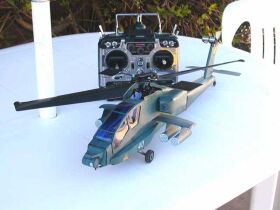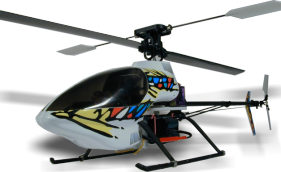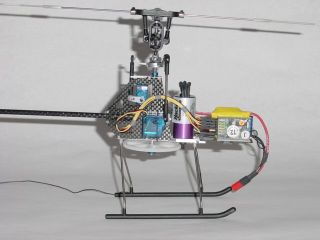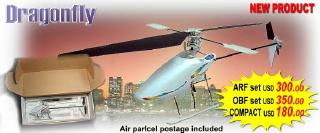Helicopter Glossary
Collective Pitch / CP / C/P
A rotor head design where the main rotor blades are free to change their angle relative to the mainmast, under control of the pilot. This is the normal control system for both full-size, and larger model helicopters. Both positive and negative pitch angles are allowed, with negative angles being required for inverted flight, rapid controlled descents, and auto-rotations. CP gives far more precise control of the aircraft in all flight regimes, but especially in the vertical axis.
Fixed Pitch / FP / F/P
A rotor head design where the main rotors are attached to the rotor head at a fixed angle (or pitch).relative to the main rotor mast On a fixed pitch helicopter, vertical control is attained by speeding or slowing the main motor. This causes the main rotor speed to increase or decrease, which produces more lift (and a subsequent climb) if increased and less lift (and a sink) if decreased. With Micro Helis, FP is far more common than CP.
Headspeed
A bit of a misnomer really., headspeed is a generic term for the speed of the main rotor measured in revolutions per minute (rpm). In general terms, the higher the headspeed, the more precisely the heli will handle. The lower the headspeed, the more 'mushy' the heli becomes.
Back to Top of Page
Radio Control Glossary
Receiver / Rx
The airborne component of your Radio Control Equipment that collects the radio signals from your transmitter, and decodes them into commands to be sent to the servo's and ESC.
Servo
An electro-mechanical device that takes the decoded signals from the receiver and translates them into movements of the control surfaces.
Battery Glossary
mAH - Milliamp/Hours.
Standard measurement for battery capacity, expressed as the ability to deliver a certain current draw for a certain period of time. Generally today these measurements are expressed at the one hour rate. For example, a 1200 mah battery would be expected to be able to deliver 1.2 Amps (1200ma) for approximately one hour before going flat.
Some typical mah values for batteries used in MicroHelis are:
AAA NiCad - 250mAh
AAA NiMh - 720mAh
1200 Li-Poly - 1200mAh
If we know the total average current draw of the Micro-Heli in flight, we can use the mah figure to approximate the flight time of the heli on a single charge. If we know for instance that the heli draws 3 Amps (3000ma), the approximate flight times will be:
AAA NiCad - 250mah. 3000ma/250ma = 12.0 One hour (60 mins)/12 = 5 mins - 0% loss = 5 mins
AAA NiMh - 720mah 3000ma/720ma = 4.2 One hour (60 mins)/4.2= 14 mins - 30% loss = 10 mins
1200 Li-Poly - 1200mah 3000ma/1200ma = 2.5 One hour (60 mins)/2.5= 24 mins - 0% loss = 24 mins
You'll notice the addition of a 'loss' column above?
Micro Helis generally draw somewhere in the 2-3 Amp range, and at this point we discover that all batteries are not created equal. Although all batteries should be able to deliver their one-hour rate current, many batteries 'loose' capacity when drained at currents exceeding the one hour rate. The amount of loss depends not only on the chemical makeup of the battery, but also on the manufacturer.
In general, good quality NiCads and the new Hi-drain Li-polys will loose very little capacity, whereas NiMh cells can loose 30% of capacity under loads greater than 1C. (For an explanation of 'C' see its entry in this glossary). The figures above are pretty indicative of 'real world' flight times, so you can see why people are flocking to the new Li-poly batteries.
A word about manufacturers. There is a wide range of quality in battery cells, and some cheaper cells may claim high mAh ratings but be totally unusable for Microhelis.
I had a 300mah nicad pack that would happily deliver 300mah at 30ma drain (useless for our purpose), but at 3 Amps would only deliver 150mah! So what theoretically should have been a Six minute flight pack actually struggled to give me 2 and a half minutes!
In the worst case scenario, a battery may be not be able to supply enough power to get the Micro-Heli into the air. So, when purchasing batteries for Micro-Helis, it pays to check with other flyers to see what batteries perform best under Micro Heli loads.
C - Current expressed as a ratio of rated capacity.
C is a way of expressing current draw (or charge current) as a ratio of the battery's capacity. You will usually find C in manufacturers specs, in regard to charge/discharge rates, and it is normally preceded by a number, such as 1C, 2C, 4.5C.
So what does it actually mean? Well it's easier to demonstrate, than explain it.
One well known NiCad/NiMH battery rule, is that the initial charge of a new battery should be 12-14 hours at 1/10C. This means you should charge the battery for 12-14 hours with a current no greater than one tenth of the battery's rated capacity. So if it is a 250mah NiCad you'd charge it at 25mA, a 2000mAh battery would be charged at 200mA, and a 720mAh NiMH at 72mA.
Another charging rule is not to exceed 4C when charging NiCads, 2C for charging NiMH, and 1C for Lithium based batteries. So applying this rule:
250mAh NiCads - should not be charged at more than 4C - so in this case 4x 250mA=1000mA = 1.0A max charge current
2000mAh NiCads - should not be charged at more than 4C - so in this case 4x 2000mA=8000mA = 8.0A max charge current
720mAh NiMHs - should not be charged at more than 2C - so in this case 2x 720mA=1440mA = 1.44A max charge current
1200mAh Li-polys - should not be charged at more than 1C - so in this case 1x 1200mA=1200mA = 1.2A max charge current
One 'nice' use of C which is just starting to catch on is in relationship to a batteries capacity under load.
If you've read the mAH entry, you will have seen mention of the fact that batteries 'loose' capacity when the load exceeds 1C. Manufacturers of the latest hi-discharge li-poly cells are starting to list not only the one-hour capacity, but also the expected capacity under load.
Taking the new Kokam 1500 as an example, the cell's nominal (one-hour) capacity is 1500mAh, but Kokam also give us another rating to work with - 8C/82%.
This tells us that at 8C discharge, we can expect to obtain 82% of the nominal capacity of the battery. Working this out we find that at a 12A (8 X 1500mAh) discharge this battery will still deliver 1230mAh (82% of 1500mAh) of capacity. Pretty darn impressive eh?.
So, in summary, take the rated capacity of the battery as C, multiply that by the number in front of C and you have the current.
Back to Top of Page
Motor and Other Electronics
Governor (CP only)
A device designed to maintain a constant headspeed regardless of the pitch angle of the blades. A well set-up governor arrangement will allow the heli to be flown using only collective pitch. This eliminates the need to set up throttle curves, and makes the handling of the aircraft far more consistent across a wide range of flight modes. A governor is not a necessity, but it is a nice thing to have.
Back to Top of Page

 Web Wide Hosting
Web Wide Hosting




